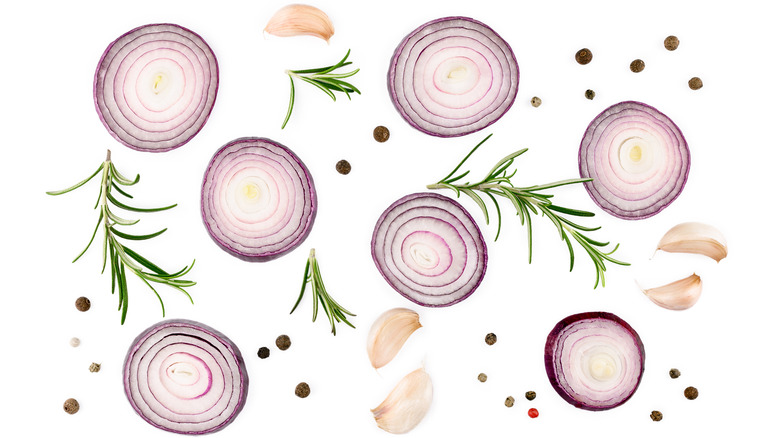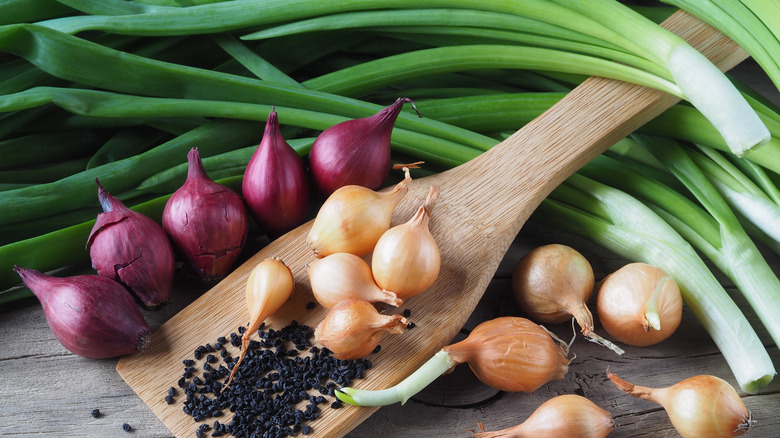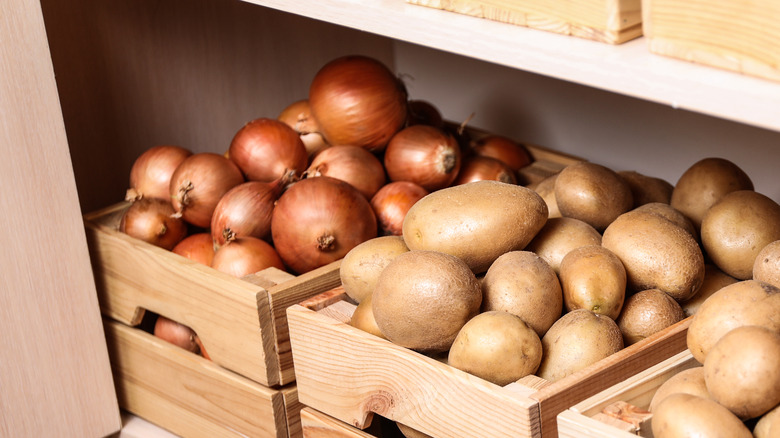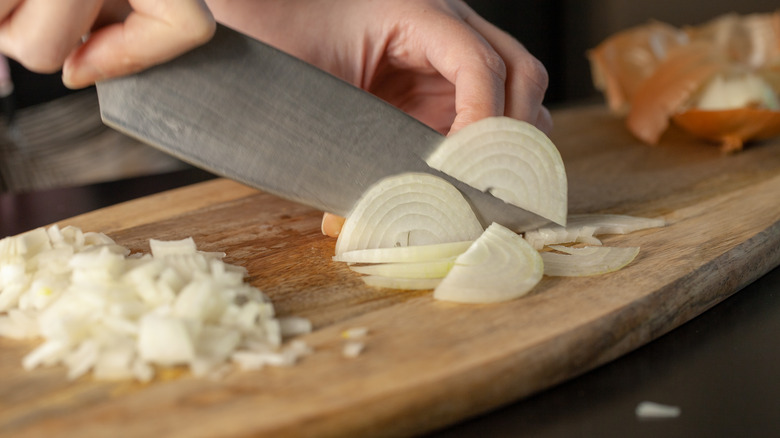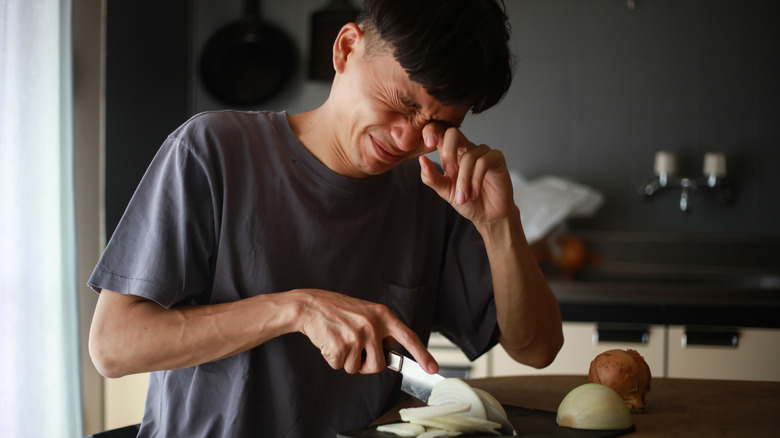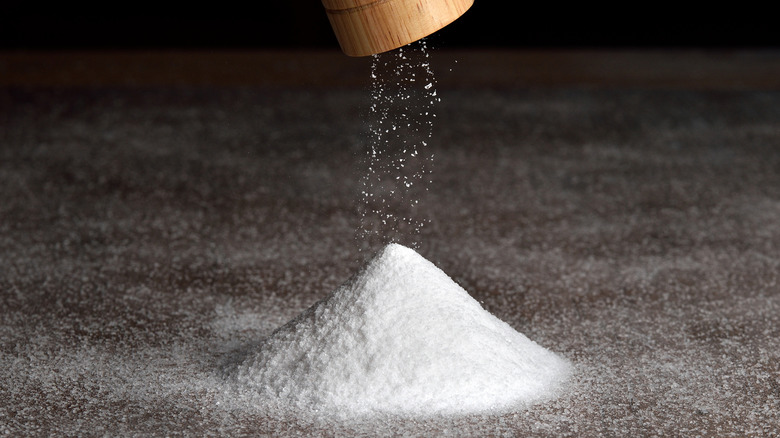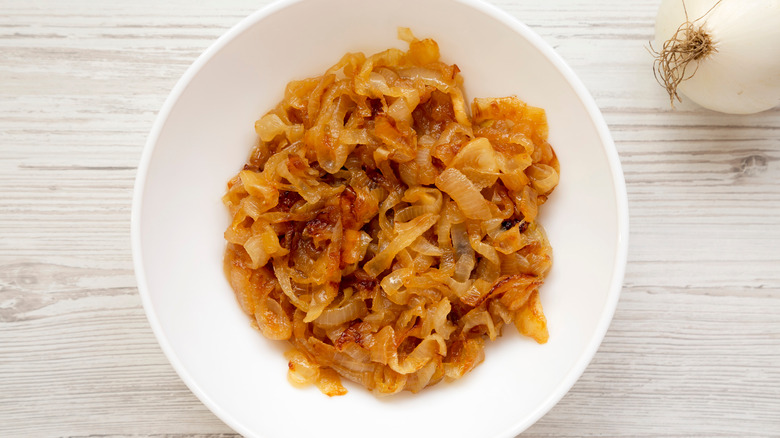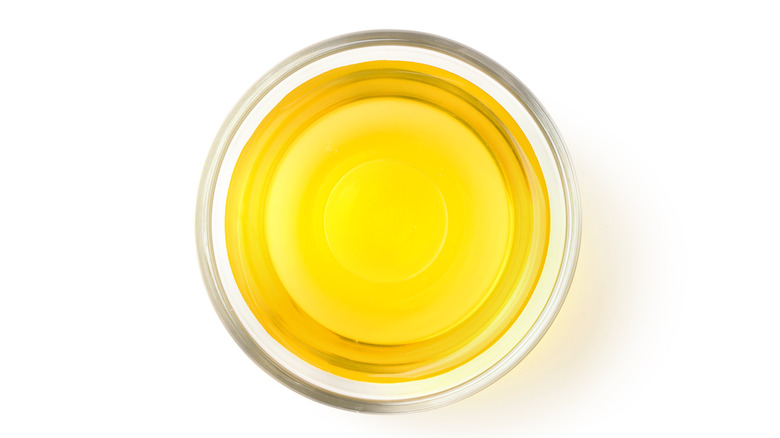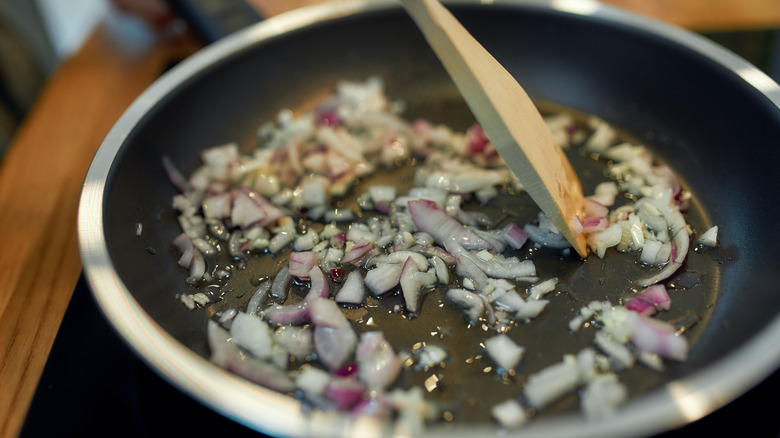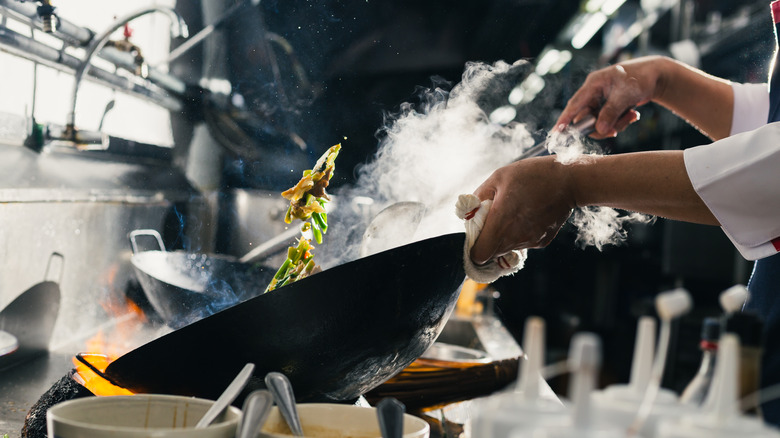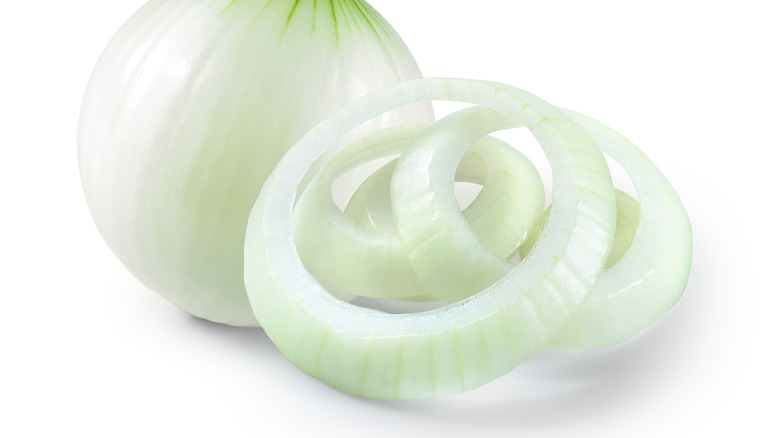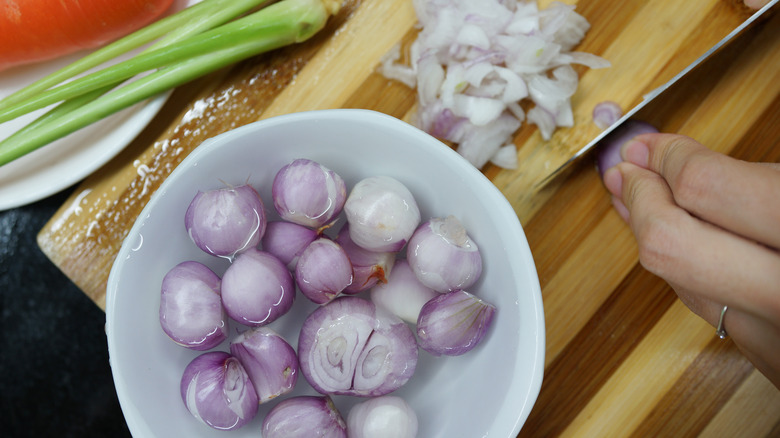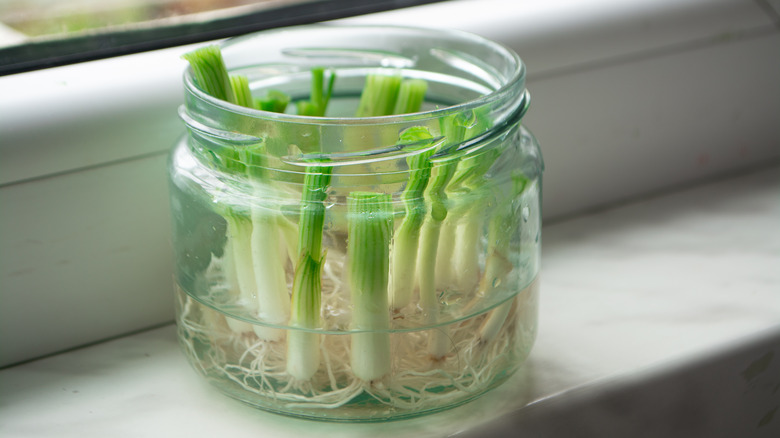Tips You Need When Cooking With Onions
Onions are one of the most-used, most versatile ingredients in the world, and chances are, if you cook on even a semi-regular basis, you have some in your kitchen right now. But just because you always have onions on hand doesn't necessarily mean you know how to cook them perfectly every time. If you find that your onions usually turn out too raw, too burnt, or too mushy, then it may be time to get the scoop on how best to cook them so they always taste their best in whatever recipe you're throwing together.
We've collected all the most important info on cooking onions and bringing it to you here, all in one place. From shopping for the best onions for the job to cooking and serving them, these tips will help ensure that onions will always make your dishes better. So, light a candle, get shopping, and prepare yourself for a good cry, because these are the tips you need when cooking with onions.
Use the right onion for the job
You may think that all onions are created equally, but unfortunately, that's just not true. While you can find a good recipe for pretty much any kind of onion you have in the house, when it comes to planning a specific dish, you're going to want to get the right type of onion for the job. After all, a scallion and a red onion just aren't going to show up the same way in different dishes, so it's important to know what you're shopping for before you do anything in the kitchen.
If you're looking for a versatile onion that can be used in all kinds of recipes, Treehugger says you should opt for a yellow onion. You can eat them raw for a sharper taste, but they also cook down quite nicely. Red onions are great if you want to eat them raw, perhaps in a salad, and they may just be your go-to if you prefer grilling your onions. White onions are similar to yellow onions, though they can be more pungent even after they're cooked. Sweet onions and shallots both impart a milder, sweeter flavor that can be perfect if you're trying to caramelize them. And green onions or scallions can be left raw for a crunchy, flavorful garnish or added into stir fry or pasta dishes.
Before you go to the store, check to see what the recipes you're cooking from call for. That way, you can make sure you buy the best onion for the job.
Store your onions properly
You may be the type of person who goes to the store every few days to pick up more produce, but if you like to stock up on essentials like pasta, rice, and, of course, onions, then you'll want to know how to store your onions properly. After all, it doesn't do you much good to understand how to cook an onion perfectly if you never have a fresh one in your kitchen. While you may think it's a good idea to leave your onions in the fridge, Better Homes and Gardens says that's actually not a great idea. Instead, look for a "cool, dry, well-ventilated place." The bottom of your dark pantry is probably your best bet.
However, not all onions can be stored the same way. Heartier winter onions will keep for weeks on end before you have to use them up. But you're going to want to use up those spring and summer onions (like scallions) earlier, as they'll go bad sooner. Following these guidelines will ensure that your onions will always be fresh and ready to go whenever you decide to cook with them.
Cut, dice, or chop your onions evenly
The next thing you'll want to do is to get chopping. For some people, this is the most dreaded part of cooking an onion because of the inevitable tears that well up in your eyes if you're chopping more than about a quarter of an onion. But don't worry, we'll get to that later. First, we should focus on how to make sure we're chopping onions properly. According to Fine Cooking, it all comes down to making sure we're keeping things even, whether we choose to cut, dice, or chop. Why is it so important to keep all your pieces of onion somewhat even? Once you put all of that onion into a pan, you're going to want to make sure everything cooks evenly. If you have some chunks of onion that are significantly larger than others, then you'll have some pieces that are more raw than others — and that's probably not what you're going for.
Of course, if you're preparing onions for a salad, you can first cut your onion in half and then cut it horizontally. However, if you're going to be cooking your onions, you're better off "cutting slices from pole to pole, rather than across the equator." That way, you'll have pieces of onion that are roughly the same size and that will cook more evenly.
Wear contacts if you have them
Now that you know how to chop your onion properly, we can focus on how you're going to keep yourself from bawling while doing so. You've probably heard a ton of advice on how to prevent onions from making you cry, but whether it's lighting a candle or putting a wet paper towel in your mouth when you chop, you may have realized that these tips and tricks seldom work. Your best bet? Wearing contacts, says So Yummy.
Wearing your glasses isn't going to do the trick here — you're specifically going to want to use contacts. That's because they actually create a barrier between your eye and the contaminated air, while glasses still allow that onion-y air to come into contact with your eyes. Of course, if you're not afraid of looking silly, goggles could potentially do the trick as well. However, if you've been cursed with poor eyesight and need to use your contacts to see on a daily basis, you're actually pretty lucky in this case. Just make sure to wash your hands thoroughly before you try to take your contacts out.
Add salt to your onions to help break them down
Now, it's finally time to start cooking. Whether you're frying, sautéing, or caramelizing your onions, you're going to want to throw them in a pan with the fat of your choice and start turning up that heat. But you're not going to want to walk away after you complete those first few steps. Rather, if you want your onions to cook to perfection, you're going to want to remember to sprinkle on some salt after you throw them in the pan. Why is salt so important here? Well, it helps to release moisture from the onions. This will help soften them and allow them to cook faster, while also adding more flavor to the dish.
In addition to aiding in the actual cooking process, adding salt to your onions early on helps add flavor to your dish that you can build on as you continue cooking. It's an indispensable step that every home cook should be doing if they want their food to taste as good as possible. Our suggestion? Keep a container of salt at the ready while you're in the kitchen so you can always add a dash of salt as you cook.
Take the time to truly caramelize your onions
If there's one thing — and only one thing — that you should know about cooking onions, it's that a lot of recipes online are lying to you about how long it really takes to caramelize onions. Some recipes might lead you to believe that you only have to spend about five minutes standing over a pan to achieve the caramelized onions of your dreams. But, alas, that's not the case: It's actually going to take you quite a bit longer than that to caramelize your onions to perfection. According to Taste Magazine, you're looking at about 45 minutes from pan to plate if you want to get your onions nice and jammy and browned.
That being said, if you're in a major rush, Taste has a few ideas to speed things up. First of all, you could always add a pinch of sugar to the pan. Since this jumpstarts the caramelization process, it might shave a few minutes off the routine. If you don't have any sugar sitting around, a touch of baking soda can also get the job done: It helps break the onions down faster. Of course, even if you're using these extra ingredients, you should still remember to salt your onions during this step.
Use oil to caramelize your onions
When it comes to cooking just about any vegetable, what's one ingredient that can always make things more delicious? If you ask us, it's all about the butter. Therefore, when you're getting ready to caramelize your onions, it only makes sense to think that butter should be your fat of choice when you start cooking. However, we're afraid that you may not want to go overboard with the butter if you're trying to ensure that you don't burn anything. According to Bon Appétit, butter has a low smoke point, which means it has the tendency to burn easily. That could easily ruin your onions, which is why they suggest using oil to caramelize your onions.
Oils like canola and vegetable have a higher smoke point, meaning they're not going to be quick to burn, making them ideal for cooking ingredients for long periods of time. But don't worry: You don't have to stick to only oil if you want the flavor of the butter (though using oil alone is totally fine as well). A mixture of butter and oil will give you the flavor you want without making your onions burn in the process. Sure, it's one extra step, but it's worth it if you want your onions to come out of the pan looking — and tasting — perfect.
Make sure not to crowd the pan while you're cooking your onions
When you're ready to start cooking your onions, make sure you take out a larger pan if you're cooking more than about a half an onion. That's because you're going to want to avoid overcrowding your onions as they cook, according to Bon Appétit. This is especially true if you're trying to get your onions nice and browned, whether you're sautéing or caramelizing. That's because when you have too many onions in the pan, there's nowhere for the evaporating water to go. All that liquid gets stuck in the pan, which means that it's going to take way longer to get that browning you want.
Bon Appétit says that you should be able to cook two large onions in a 12-inch pan, so that's a good rule of thumb to go by if you're unsure of where to start. Otherwise, just use common sense. If there are several layers of onion in your pan, you're going to get that undesirable steam. Choose a larger pan, or cook your onions in batches.
Use onions as a base for your other veggies
Sometimes, you're adding onions to a dish for crunch and flavor, and in that case, you're not going to want to cook them for too long. But for so many recipes, onions contribute to a dish by providing flavor rather than actually becoming a substantial part of the final product. If you're working with a recipe that falls into the latter category, you're probably going to be throwing the onions into the dish before any of your other veggies. Per The Kitchn, this allows those onions to form a nice base for the rest of the ingredients. Therefore, you'll want to get them translucent — without browning them too much — before adding in the rest of your other ingredients. Eventually, those onions will "melt" into the other ingredients, adding a ton of flavor without taking up much space.
Of course, when it comes to stir fry recipes or any other dishes in which you want a stronger onion flavor and a more noticeable crunch, letting those onions cook down isn't necessary. However, most of the time you're going to be cooking with onions, make sure you throw them into the pan first.
Cut thick slices if you're grilling your onions
Most of us probably cook our onions on the stove or in the oven the majority of the time. But that doesn't mean that you can't do other things with your onions. In fact, if you're grilling out, you may want to add some onion slices to your spread. Not only are grilled onions an easy, inexpensive, and delicious side dish that's easy to throw together in a matter of minutes, but cooking them alongside your other ingredients is sure to make your next grill-out a hit.
But how exactly do you prepare onions for the grill? As you've probably already realized, you're not going to want to chop or dice an onion you plan on putting on the grill. Instead, it's better to cut your onions into slices. Wondering how thick you should make them? The National Onion Association suggests cutting your onions at least a half-inch thick if you want to ensure that they're not going to fall apart. This should give you about four to six slices per large onion. Since onions do shrink down a bit when they've been grilled, you may want to snag a few more onions than you think you need, just in case.
Soak raw onions in water for a milder flavor
Love the flavor of raw onions, but just can't handle the intensity? If so, you're not alone. For those who want to enjoy onions in their salad without walking around with bad breath for the rest of the day, there's a solution so simple you'll wonder why you haven't thought of it before: soaking your raw onions. According to the Los Angeles Times, soaking your onions in water before serving them "softens" the flavor. Therefore, that pungent smell that makes onions such a versatile ingredient can be toned down a bit just by adding some water.
For this step, you'll want to use cold water. Place your sliced or chopped onions in a bowl of cold water for about 15 minutes. Once that time is up, thoroughly drain your onions and set them aside. Then, serve them in whatever dish you're making. Your salad, sandwich, or ceviche won't be quite as intense.
Regrow your green onions
If you love scallions just as much as we do, then you know how annoying it is to run out when you're thinking of making a recipe that needs them. But did you know there's an easy way to ensure you always have green onions stocked in your fridge? As long as you keep the bottom of your scallions (where the root is growing from), you can place those roots in water or dirt, and a new scallion will eventually grow, according to AllRecipes. Just place the root ends in a shallow dish, and fill the dish with water until new onions start to grow. When they get larger, transfer them to a pot. You'll have new green onions growing in no time. Then, repeat the process and grow them again and again.
This is a great way to make your kitchen just slightly more sustainable, and it'll save you money in the process. What's not to love about that? It's a green kitchen hack that doesn't take up too much of your time.
